Front Row breaks barriers to performing arts for young millennials
Daniel Handler, aka Lemony Snicket, headlines one of Cal Performances' innovations, aimed at bringing more young adults to the performing arts
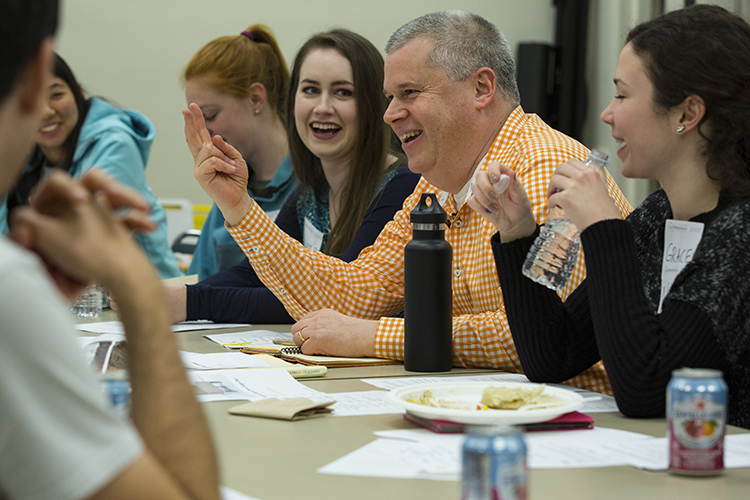
February 16, 2017
Grace Asia Lee, 19, often begs her UC Berkeley friends to join her for a play, a concert or the ballet. But so far, the answer’s been no.
“The performing arts aren’t trendy. People my age assume they’re a hobby for older people,” says Lee, a sophomore whose childhood was steeped in dance, art and music. “If they had more awareness of them, more people would go.”
Cal Performances, knowing the Millennial Generation is the audience of the future, is building that awareness through the innovative Front Row program.
Funded through a multi-year grant from The Wallace Foundation, Front Row tests a theory that if 18- to 22-year-olds get the chance to envision and produce their own shows, they and the young audiences they attract will connect better with what’s on stage, both now and after graduation.
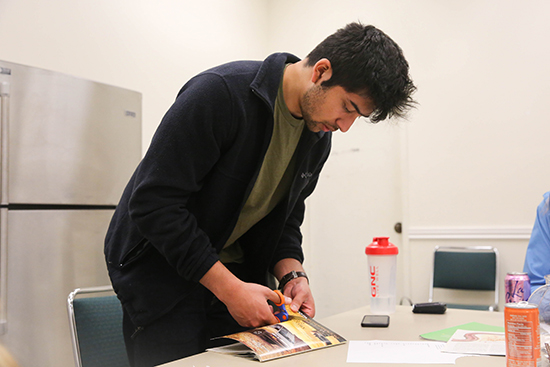
Each week, Rohil Taggarsi and other student curators have met in Zellerbach Hall to prepare for the Daniel Handler show. (UC Berkeley photo by Sara Yogi)
Next Wednesday, Feb. 22, the Zellerbach Hall curtain will lift at 7 p.m. on this year’s student-curated Front Row event. Lee and 13 other undergraduate volunteers from diverse majors have designed a show with and around one of their heroes — bestselling author Daniel Handler, also known as Lemony Snicket, whose popular A Series of Unfortunate Events children’s novels are now a TV series from Netflix.
“I read all his books in fifth grade and haven’t forgotten them since. I’m a huge fan,” says Rohil Taggarsi, an integrative biology major and a member of Student Curators of Cal Performances.
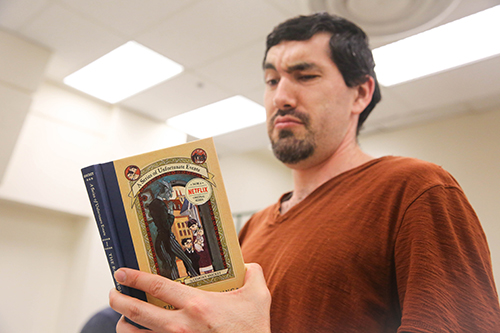
Student curator Alex Parkin cracks open one of the 13 novels that comprise Handler’s “A Series of Unfortunate Events.” (UC Berkeley photo by Sara Yogi)
“I said yes before they could change their minds,” quips Handler, a Bay Area resident who’s collaborated with the students since last April. In “Front Row with Daniel Handler and Friends,” the novelist and philanthropist will interact on stage with an eclectic mix of individuals who have deeply influenced his life — master perfumer Yosh Han; indie folk-pop musician Thao Nguyen; Cecile Richards, president of Planned Parenthood; songwriter, musician and producer John Vanderslice and poet Matthew Zapruder.
If next week’s Front Row show is anything like the inaugural one the group curated last March — the $5-a-ticket, sold-out event highlighted Metallica drummer Lars Ulrich and a few of his Bay Area friends and colleagues — it’s likely to be a magnet for Berkeley students, who just might return for more.
Barriers to break
Americans’ overall rate of annual participation in the so-called “benchmark arts” — art museums and galleries, musical theater, non-musical theater, classical music, jazz, dance, ballet and opera — has been dipping for a few decades, from a high of 41 percent in 1992 to 33 percent in 2012, according to the most recent data from the National Endowment for the Arts’ Survey on Public Participation in the Arts, as reported by The Wallace Foundation. The foundation is dedicated to the vitality of the arts and funds audience-building initiatives.
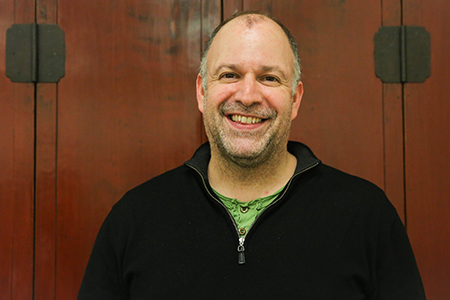
Cal Performances Associate Director Rob Bailis is the creator of Front Row. (UC Berkeley photo by Sara Yogi)
That fall-off in attendance, says Lucas Held, the foundation’s communications director, is likely due to multiple factors, including the erosion of K-12 arts education, increased competition for leisure time, and shortened attention spans that respond to texting and other digital distractions over live performance.
“Students are coming to college less familiar with art forms than in the past,” says Held. “Lack of familiarity with something often is a barrier to participation. If I know nothing about something, I’m going to be a little leery about whether I’d enjoy it and understand it.”
At Cal Performances, the country’s largest university performing arts presenter, 47 percent of ticket holders are Berkeley alumni, staff, faculty and students, and students comprise 8.7 percent of the total audience.
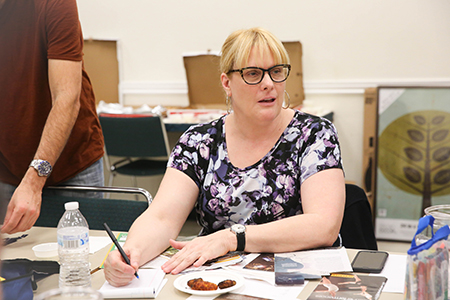
Kathy Rose, producer of special initiatives for Cal Performances, is a mentor for the student curators. (UC Berkeley photo by Sara Yogi)
“Deep incentives for students have always been available, but had stalled in their effectiveness,” says Rob Bailis, Cal Performances’ associate director and Front Row founder. “With programs like Front Row and Cal Performances’ other student initiatives under Berkeley RADICAL, that 8.7 percent is up from 5 percent in 2015. We’re on our way to our goal of students comprising between 12 and 15 percent of our total audience.”
Berkeley RADICAL (Research and Development Initiative in Creativity, Arts, Learning), a central tenet of Cal Performances, is designed to cultivate the artistic literacy of future audiences and to connect innovative artists worldwide with Berkeley’s intellectual capital.
Bailis created Front Row with the strategy that giving undergraduates authorship of what’s on stage might break barriers to their engagement with the performing arts. His idea caught The Wallace Foundation’s eye, and from a pool of 300 organizations that applied for funding, Cal Performances became one of 25 receiving a total of $40 million in grants from the foundation’s Building Audiences for Sustainability initiative, which began in 2015.
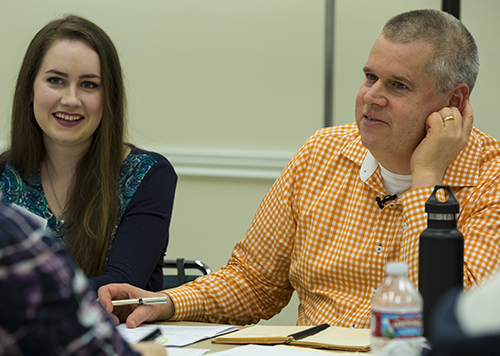
Daniel Handler, next to student Grace Paxton, says “anyone who is willing to sit with me in a windowless room talking discursively and at flighty length about the intersectional merits and philosophies of various artists…is a delightful collaborator.” (UC Berkeley photo by Stephen McNally)
“Broadly speaking, we look for arts organizations with strong plans, the financial strength and capacity to carry out a complicated initiative and that prioritize building audiences,” explains Held. “We also look for organizations that will develop credible evidence about what works, what doesn’t work, and why, that can generate lessons useful to the broader field.”
“All of those things,” he says, “made Cal Performances a good choice.”
Authorship as engagement strategy
Each spring, the Front Row student curators are assigned to select, and then meet and interview, an internationally known Bay Area creative figure who students find inspirational. The artist then gives a list of his or her major influencers to the students. They research each one, narrow down the list and begin populating the stage with a carefully considered mix of guests.
“The first rule of curation is to create a frame that causes things within it to have a unique resonance with each other,” adds Bailis. Themes emerge as the students curate; common threads among the guests in the upcoming Handler show are a shared passion for activism, innovative approaches to creativity and storytelling, and one-of-a-kind careers. For the Ulrich show, it was creativity, innovation and fatherhood.
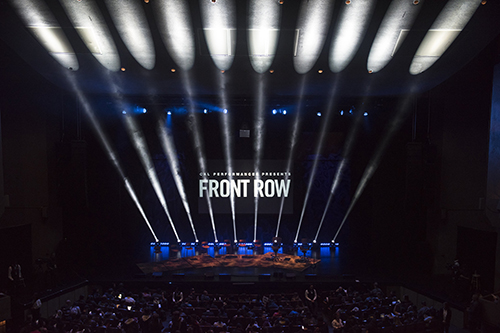
Front Row 2016 featured Lars Ulrich, famed founding drummer of Metallica. (Photo by Natalia Perez)
The students chose the name Front Row in hopes that their peers in the audience will “feel like they have a front row seat and get a close look at the participants — both physically and metaphorically,” says Kathy Rose, producer of special initiatives for Cal Performances.
Mentors like Rose and Sabrina Klein, Cal Performances’ director of artistic literacy, help the student curators “touch on every portion of creating an event,” says Rose, including program flow, marketing, running social media, production and pre- and post-show events in the lobby.
“It’s so cool to work tirelessly on a project long-term and watch everything come together gradually,” says Taggarsi, 21. “It’s one thing to see an event from the audience’s perspective, but it’s another thing to oversee what goes on behind the scenes.”
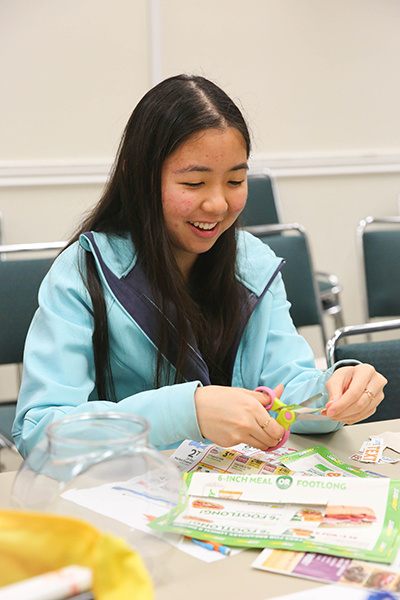
Grace Asia Lee snips words from magazines for a poem-writing activity students will host in Zellerbach’s lobby next Wednesday night. (UC Berkeley photo by Sara Yogi)
“Front Row has changed the way I look at the performing arts,” agrees Lee, a business and economics major, adding that she’s proud of “pioneering a new type of event.”
The students add that meeting and working with the guests is a highlight. “Handler is a very interesting, funny and quirky guy,” says Taggarsi, “and his works are an extension of his thoughts and his mind.”
“He’s also warm and unpretentious,” adds Lee. “I had an image of him based on A Series of Unfortunate Events, and I wasn’t expecting him to take us very seriously. However, he is very passionate about Front Row, and it’s great to work with him.”
Next Wednesday, before and after the performance, the students will assist the guest artists and also run “immersive experiences” in Zellerbach’s lobby that reflect Handler’s Lemony Snicket side and “give little hints of all the people you’ll encounter on stage,” says Rose. Ticket holders can have their photos taken with life-size images of the performers, for example, visit a perfume station and try their hand at writing poetry.
“The lobby is important. We want students to come and hang out and feel comfortable in the theater,” says Rose, adding that it will remain open an hour after the show and offer plenty of free snacks and beverages.
SpeakEasy, JoinMe and more
Front Row is just one of several programs that Cal Performances has created for young adults. Others include:
- SpeakEasy. Also funded by The Wallace Foundation, a SpeakEasy is a reception at Zellerbach Hall held for 50 to 60 students after particular performances. “They want to be able to talk about the show with their friends afterward, so we provide them with a room and refreshments,” says Klein. “Performers, or a conductor, frequently will stop in and answer their questions.”
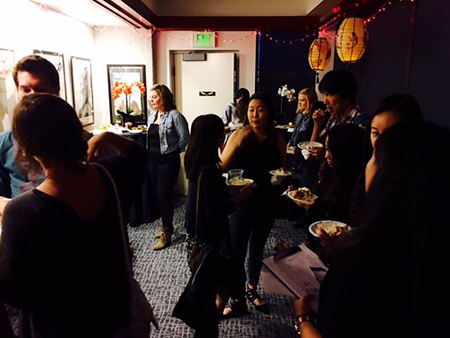
A SpeakEasy gives students a post-performance place where they can talk about the show with each other and the artists. (Photo courtesy of Cal Performances)
- JoinMe. This bring-a-friend program is for up to 25 students enrolled in select academic courses that integrate Cal Performances’ programming into the classroom. Funded by a five-year grant from the Andrew W. Mellon Foundation, the courses include a free ticket for each student to several campus performing arts events, plus an extra ticket for a friend.
- SAFTA (Student Ambassadors for the Arts). Several dozen students help “break down the mystique of the performing arts” with their Berkeley peers, says Klein, through outreach via social media, SpeakEasy receptions and by hosting master classes with visiting artists.
- Night Out/Night Off. Once each semester, in a joint effort between SpeakEasy and the Office of Graduate Diversity, students of color attend a Cal Performances event with a SpeakEasy afterward. “Sometimes, at arts venues, you can feel like the only person of color there,” says SAFTA member Naniette Coleman, an African American graduate student. “This event is for people of color to see that Zellerbach Hall and the arts are for them, too.”
- Cal Student FlexPass. For $40, Berkeley students get four tickets annually to use at any of 60 Cal Performances events. “Those are getting cashed in and used at a high rate,” says Klein. “We sell out of them.”
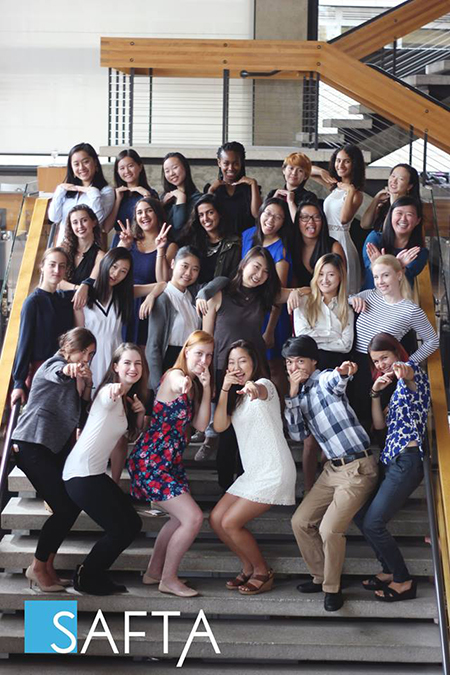
Members of Student Ambassadors for the Arts do outreach to their Berkeley peers about the performing arts. (Photo courtesy of Cal Performances)
“Will all these programs be on-ramps to students’ future participation in the performing arts?” asks Bailis. “Situated at the world’s greatest public research university, which also is a gateway to adulthood and the future, we at Cal Performances feel we have a mandate to make sure the field of the performing arts will go on, and will be accessible to all. We hope by breaking some barriers to participation, that increasing numbers of students will go into the theater and engage with live art.”
The value of the performing arts, says Held, is that they “confer a very broad range of benefits, from individual — like pleasure and captivation — to those that have a spillover effect into the public sphere — like deeper understanding of other cultures and the opening up of new perspectives. They also bring benefits to the community, like community cohesion and the understanding of history and shared culture.”
Adds Handler, “As the arts get battered in America, it is essential to remind those who are not participating, for one reason or the other, that a performance can be one of the most transformational experiences of one’s life.”
Taggarsi’s work as a curator for upcoming Daniel Handler show already has had an effect. “I know Front Row will drive me to take part in more events in the future,” he says, “and to join Cal Performances after I graduate.”